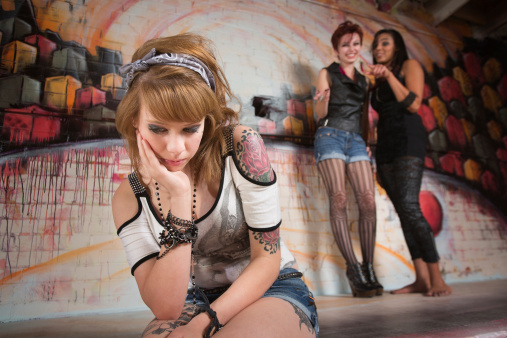Enough with this sexist stereotype. The majority of my experiences with girls and women has been positive, even life affirming.
In 1988, when I was in eighth grade, I contracted an eye infection and wasn’t able to wear my contact lenses. At the time, my eyeglass lenses were inches thick—just like the proverbial Coke bottles—and I wasn’t about to walk around looking “like a freak,” as I told my parents. I could hardly bear to wear my glasses at home, or to look in any mirror and see them on my face—heavy, nerdy, unavoidable.
The problem was that I literally couldn’t see without glasses or contacts. I went to school anyway, and spent the morning walking around in a world where I recognized only colors and, vaguely, shapes. I stumbled around the hallways of my junior high, squinting, failing to recognize my friends, running into people, and groping my way around rooms using desks and chairs. I had been afraid of looking uncool, especially in front of my girlfriends. It is not an understatement to say that for those few hours I looked more uncool than I ever had before.
My girlfriends, appalled and worried that I might hurt myself with all this lurching about, devised a plan; by the end of the third class period, they had developed a tag team system to guide me around from class to class, stopping at my locker in between to give my sky high bangs a spritzing with the can of PermaSoft hairspray I kept on the top shelf.
They also made-up a story involving a fictional long distance boyfriend that I’d met that summer in Illinois—“Let’s call him Travis,” I remember my friend Sara saying, “And he’s older and in the Army”—who had just broken up with me via letter, which I’d received in my mailbox at home the night before. They escorted me into the bathroom, splashed water on my face, messed up my makeup (this was 1988, so picture bright blue eye shadow, skinny black eyeliner and frosted pink lip gloss that smelled fruity), and spent the rest of the school day steering me around by my elbow, explaining to everyone who asked what was wrong with me that I was simply too distraught to speak and could hardly walk due to heartbreak. “She’s a wreck right now,” Sara explained, patting my back. I stared into the blurry middle distance, feigning great sadness. “You need to give her some space.”
The dramatic dust-ups that happen among pre-teen and teenage girls are often considered part of a “mean girl” mentality, an idea that has been codified by Hollywood movies, countless dinner party anecdotes, and so-called insider parenting lore—“You know how girls can be,” people have said to me as I’m bouncing my infant daughter on my knee in a coffee shop or a doctor’s office, “Wait until she’s a nasty teenager.”
I’ve certainly met my share of nasty people who happened to be female, I had a few bullies in high school, a few girls who attempted to exile me because they were jealous of some aspect of my life or ability, and even as an adult, a few women I’ve needed to break up with, but I, like many people I know, can say that the majority of my experiences with girls and women has been positive, even life affirming.
Why all this talk about how mean and horrible girls are to one another?
Because it’s a familiar tale, and imbedded within it are shades of sexism—girls are bitchy and cruel and crafty in their abuse. They become gossipy, backstabbing women, the stuff of the worst reality shows. Girls are sneaky liars, devising elaborate schemes to trip up their friends, because, you know, all girls just hate each other. Left alone and they’ll metaphorically claw one another’s eyes out without saying a word.
Boys, by contrast, are honest with their fists, easier to “deal with.” Dudes just “get it over with,” which is so much more honest.
A new study that attempts to debunk the mean girls myth offers refreshing insights into the fact that adolescence is a charged time for boys and girls alike, full of countless trap doors of embarrassment and inexperience that are possible to fall into at any time.
What I experienced in 1988 was the opposite of the mean girls stereotypical tale we’ve been taught to believe is the truth. This idea that only girls are competitive—girls with their “psychological” warfare versus the more “straightforward” conflict (hitting, punching) between men and boys—is its own kind of early sexist assumption about the essential “nature” of men and women.
Ask any grown man who has been in a playground fight and emerged with a shiner and a split lip; I don’t think such an encounter would be characterized as free from cruelty or drama. It simply seems that “battling out” your issues with someone on a physical level is more acceptable. It makes sense. We glorify war. We glorify the physicality of battle. We accept it as an inevitable part of conflict.
The study makes waves because it illustrates the need for us to redefine our gendered notions of conflict—that girls are one way and boys are another—and understand that coming of age is difficult for everyone, regardless of gender.
Role Reboot regular contributor, Emily Rapp, is a professor in the University of Cailfornia-Riverside Palm Desert MFA program and the author, most recently, of The Still Point of the Turning World.
Related Links:

